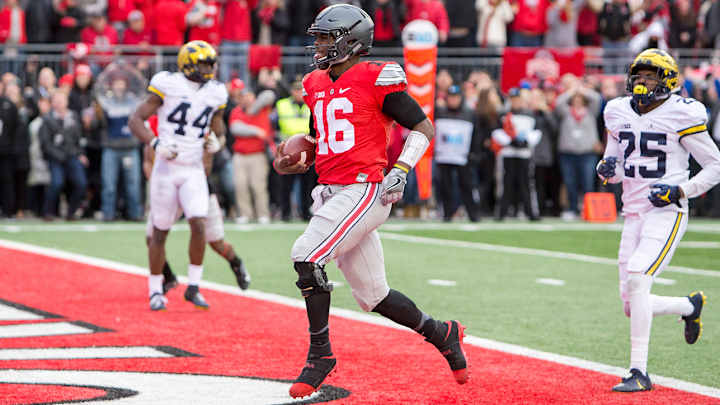The case for Ohio State to win the College Football Playoff

This story appears in the December 12, 2016, issue of Sports Illustrated. To subscribe, click here.
When Ohio State stunned Miami 31–24 in double overtime to win the 2002 national title, it marked the peak of the Jim Tressel era. The Buckeyes entered the game as 12-point underdogs, and that victory helped usher Tressel-ball into the college football vernacular. Tressel-ball meant conservative play-calling and a nearly obsessive affinity for punting.
The arrival of Urban Meyer after the 2011 season would mean a more wide-open offense, frequent fourth-down gambles and a general upgrade in football aesthetics. But as Ohio State enters the 2017 College Football Playoff with a weak offensive line, pedestrian wideouts and no game-breaking tailback, Meyer needs to rekindle the conservative ethos of his predecessor. "If Ohio State is going to win the national title," said a coach who scouted them extensively this season, "they're going to have to win it on defense and special teams."
Ohio State lifer Luke Fickell set to bring singular focus to Cincinnati
Sound familiar? The Buckeyes' offense is a paradox. It led the Big Ten in scoring offense (42.7 points per game), total offense (479.5 yards per game) and rushing offense (258.3). Junior quarterback J.T. Barrett is 26–3 as a starter. But Ohio State has sputtered against stout defenses, yielding six sacks and 11 tackles for loss to Penn State and eight sacks and 13 tackles for loss to Michigan. Any hopes of a national title in Columbus center on fending off perhaps the country's two best defensive lines, Clemson's and Alabama's.
How do the Buckeyes do that? Tressel-ball. Opponents will try to limit explosive junior running back-receiver Curtis Samuel. Penn State did that successfully in its 24–21 upset, as Samuel ran the ball only twice from scrimmage. (He delivered a 74-yard touchdown on one of those carries.) For the Buckeyes to win, they will need to figure out ways to force-feed Samuel (7.7 yards per carry), use Barrett 18 to 24 times as a runner and get 6'5", 258-pound junior tight end Marcus Baugh into mismatches. Ohio State's limited ability to stretch the field vertically will allow opponents to crowd the box, so pounding freshman tailback Mike Weber between the tackles remains a tricky proposition. "Let's face it," says the opposing coach. "He's not Carlos Hyde or Ezekiel Elliott."
The Buckeyes' 30–27 double-overtime comeback victory over Michigan offers a peek at their national title blueprint. Their only two touchdowns in regulation came off turnovers—sophomore free safety Malik Hooker returned an interception 16 yards for a score in the second quarter, and sophomore linebacker Jerome Baker snared an interception late in the third quarter and returned it 22 yards to the Wolverines' 13. The field position after Baker's pick allowed Ohio State to snap a streak of eight consecutive offensive possessions without a score.
Bowl Picks: Staff predictions for each game, the College Football Playoff
The offense's troubles force the Buckeyes to rely on their defense. They like to isolate corners Marshon Lattimore, a sophomore, and Gareon Conley, a junior, on the opposition's two best receivers, which frees Hooker to play centerfield; he has six interceptions, three of which he returned for touchdowns.
With the country's No. 4 defense, No. 5 punter (Cameron Johnson) and an eighth-best turnovers gained (25), Ohio State will play to its strengths—sound familiar, Tressel-ball fans? Maybe Meyer will even wear a sweater vest.

Senior writer Pete Thamel covers college football and basketball. Prior to joining SI in 2012, he was a national college sports writer for The New York Times.